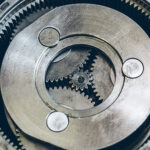A reverted gear train is very similar to a compound gear train. They are both used when there is only a small space between the input and output shafts and large changes in speed or power are needed. A simple reverted gear train consists of two shafts each of which carry multiple compound spur gears. A compound gear consists of two gears of different pitch diameters attached to one another. This reverted gear train consists of 4 double spur gears each with a gear ratio of 3:1. This assembly has two configurations. The 1st configuration allows the user to convert a a slow shaft input speed to a fast output speed. The 2nd configuration allows the user to convert a fast shaft input speed to a slow output speed. The user can change from config. 1 to config. 2 simply by dis-engaging the crank component from one shaft and re-engaging it to the opposite shaft. This device teachers the user the fundamental engineering principles of shaft speed ratios, gear ratios, and torque.

There are two major differences between compound and reverted gear trains. First, the input and output shafts of a reverted train must be on the same axis (in a straight line with one another). Second, the distance between the centers of the two gears in each pair must be the same.


